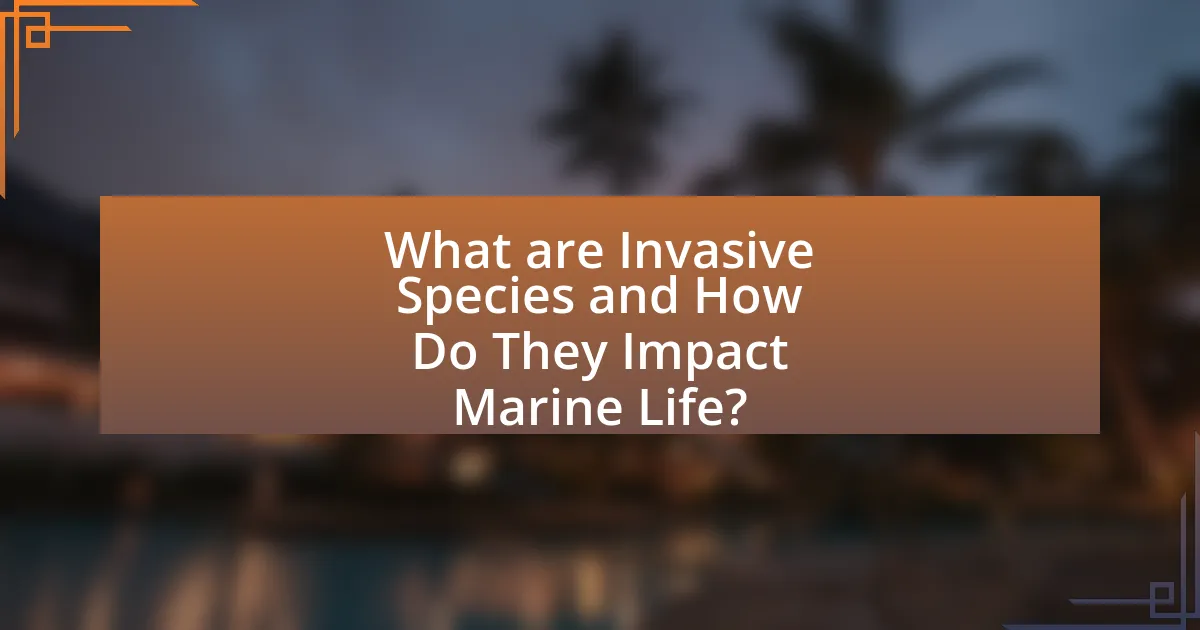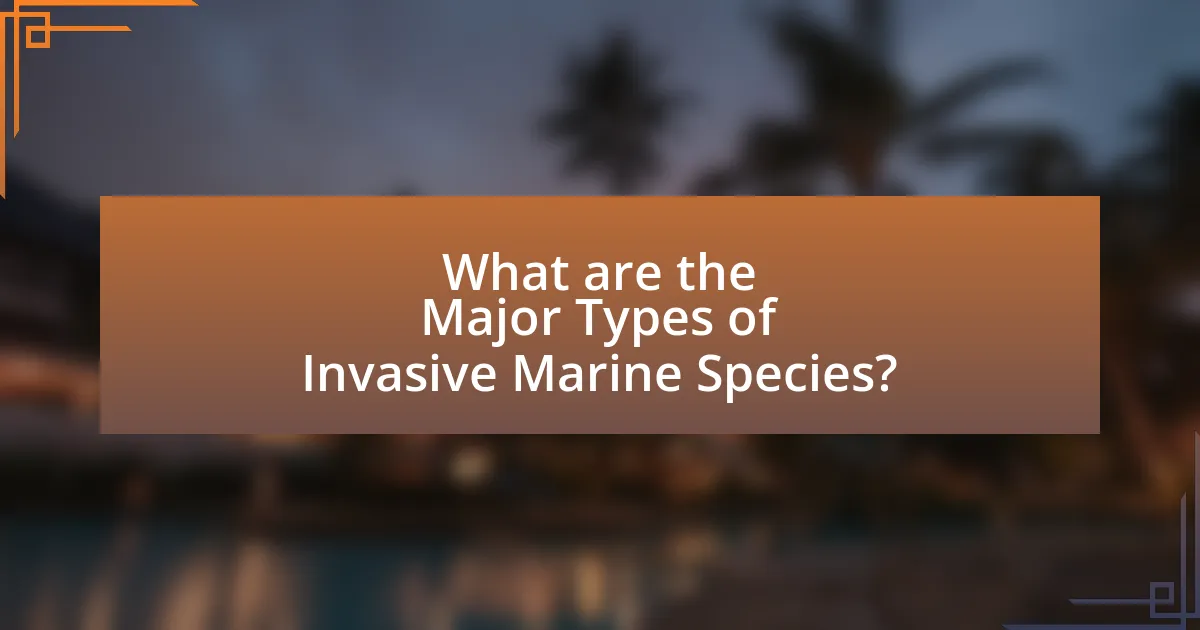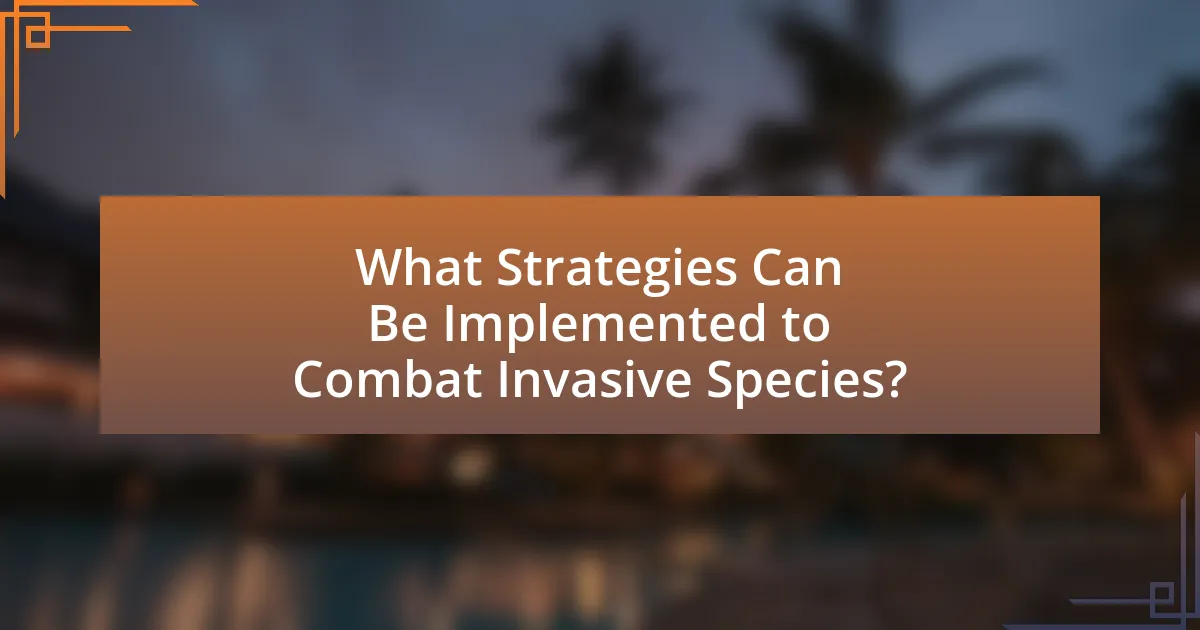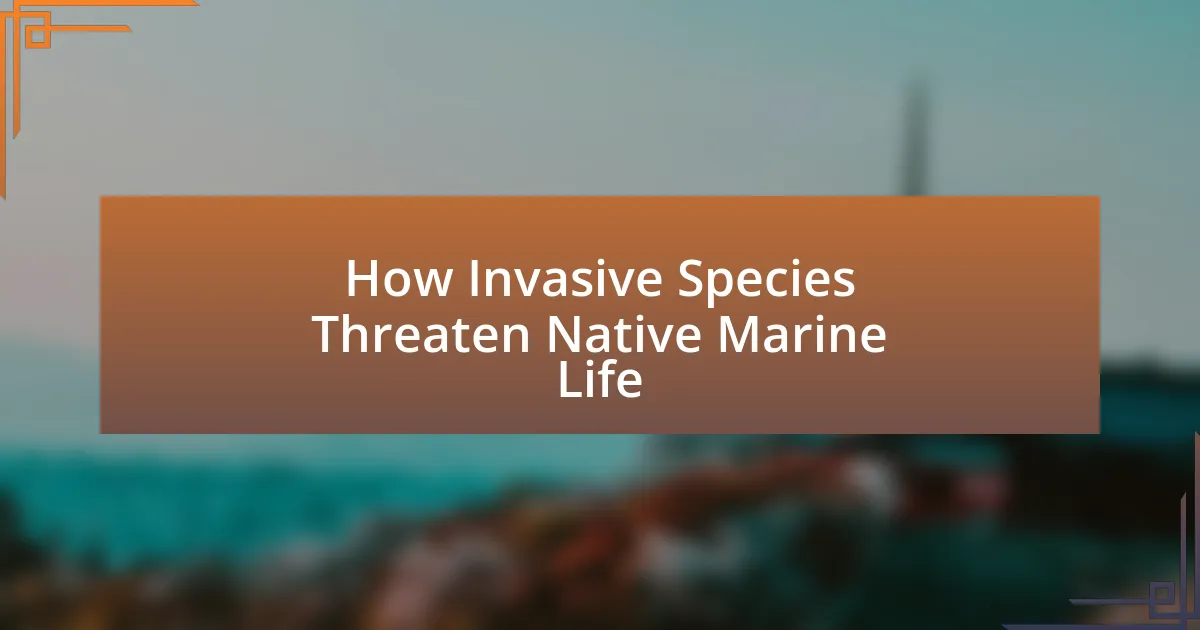Invasive species are non-native organisms that disrupt local marine ecosystems, threatening native species and biodiversity. This article examines the definition of invasive species, their characteristics, and the mechanisms through which they outcompete native organisms. It highlights specific examples, such as the lionfish and zebra mussel, detailing their ecological and economic impacts. Additionally, the article discusses the importance of addressing invasive species through prevention, early detection, and management strategies, as well as the role of public awareness and legislation in combating their spread.

What are Invasive Species and How Do They Impact Marine Life?
Invasive species are non-native organisms that, when introduced to a new environment, disrupt local ecosystems and threaten native marine life. They often outcompete native species for resources, alter habitats, and introduce diseases, leading to declines in biodiversity. For example, the introduction of the lionfish in the Caribbean has resulted in significant declines of native fish populations due to its predatory behavior and lack of natural predators in the region. Studies indicate that invasive species can cause economic losses in fisheries and tourism, further highlighting their detrimental impact on marine ecosystems.
What defines an invasive species in marine ecosystems?
An invasive species in marine ecosystems is defined as a non-native organism that, when introduced to a new environment, causes harm to the ecosystem, economy, or human health. These species often outcompete native species for resources, disrupt food webs, and alter habitat structures. For instance, the introduction of the lionfish in the Caribbean has led to significant declines in native fish populations due to its predatory behavior and lack of natural predators in the region. This demonstrates how invasive species can fundamentally change the dynamics of marine ecosystems, leading to long-term ecological consequences.
How do invasive species differ from native species?
Invasive species differ from native species primarily in their origin and ecological impact. Invasive species are organisms introduced to a new environment where they do not naturally occur, often leading to significant disruption of local ecosystems. For example, the zebra mussel, native to the Caspian Sea, has invaded North American waters, outcompeting native mussel species for resources and altering habitat structures. This competitive advantage often results in declines of native species, as invasive species can reproduce rapidly and lack natural predators in their new environment.
What are the common characteristics of invasive marine species?
Invasive marine species commonly exhibit rapid reproduction, high adaptability to various environments, and a lack of natural predators in their new habitats. These characteristics enable them to outcompete native species for resources such as food and space. For instance, the zebra mussel, an invasive species in North America, reproduces quickly and can thrive in diverse water conditions, leading to significant ecological and economic impacts. Additionally, invasive species often have broad diets and can alter local ecosystems, further threatening native marine life.
How do invasive species threaten native marine life?
Invasive species threaten native marine life by outcompeting them for resources, disrupting ecosystems, and introducing diseases. For instance, species like the lionfish in the Caribbean have proliferated rapidly, preying on native fish and reducing their populations, which alters the balance of the ecosystem. Additionally, invasive species can alter habitats, such as when the green crab invades coastal areas, leading to the decline of native shellfish populations. These impacts are supported by studies indicating that invasive species are responsible for approximately 50% of the declines in native marine biodiversity globally.
What mechanisms do invasive species use to outcompete native species?
Invasive species outcompete native species primarily through mechanisms such as resource exploitation, predation, and the introduction of diseases. These invasive organisms often have faster growth rates, higher reproductive rates, and broader ecological tolerances, allowing them to dominate resources like food and habitat. For instance, the zebra mussel, an invasive species in North America, can filter large volumes of water, depleting food sources for native bivalves and disrupting local ecosystems. Additionally, invasive species may lack natural predators in their new environments, enabling unchecked population growth that further threatens native species. Studies have shown that invasive species can lead to significant declines in native populations, as seen with the introduction of the lionfish in the Caribbean, which preys on native fish and competes for food resources.
How do invasive species affect the food web in marine environments?
Invasive species disrupt the food web in marine environments by outcompeting native species for resources, altering habitat structures, and introducing new predation pressures. For instance, the introduction of the lionfish in the Caribbean has led to significant declines in native fish populations, as lionfish are voracious predators that consume a wide range of reef fish. This predation alters the balance of the ecosystem, leading to overgrowth of algae and a decline in coral health, which further impacts the entire marine food web. Studies have shown that invasive species can reduce biodiversity by up to 50%, demonstrating their profound impact on marine ecosystems.
Why is it important to address the issue of invasive species?
Addressing the issue of invasive species is crucial because they disrupt local ecosystems, leading to the decline of native species and biodiversity. Invasive species often outcompete native organisms for resources, which can result in significant ecological imbalances. For instance, the introduction of the zebra mussel in North America has caused severe declines in native mussel populations and altered aquatic ecosystems, demonstrating the tangible negative impacts invasive species can have on marine life.
What are the ecological consequences of ignoring invasive species?
Ignoring invasive species leads to significant ecological consequences, including the decline of native species, disruption of local ecosystems, and loss of biodiversity. Invasive species often outcompete native organisms for resources such as food and habitat, resulting in population declines or extinctions of native species. For instance, the introduction of the zebra mussel in North America has caused severe declines in native mussel populations and altered aquatic ecosystems by filtering out essential nutrients. Additionally, invasive species can disrupt food webs, leading to imbalances that affect multiple trophic levels. The ecological integrity of habitats is compromised, which can result in reduced ecosystem services, such as water purification and carbon storage.
How do invasive species impact human activities related to marine life?
Invasive species significantly disrupt human activities related to marine life by altering ecosystems, which can lead to economic losses in fisheries and tourism. For instance, the introduction of the lionfish in the Caribbean has resulted in declines of native fish populations, impacting local fishing industries that rely on these species for income. Additionally, invasive species can outcompete native organisms for resources, leading to reduced biodiversity, which is crucial for maintaining healthy marine environments that support recreational activities and tourism. The economic impact is evident; the U.S. spends approximately $120 billion annually on invasive species management and related losses, highlighting the substantial financial burden invasive species impose on human activities connected to marine ecosystems.

What are the Major Types of Invasive Marine Species?
The major types of invasive marine species include mollusks, crustaceans, fish, and aquatic plants. Mollusks such as the zebra mussel and the Asian clam disrupt local ecosystems by outcompeting native species for resources. Crustaceans like the green crab can alter habitat structures and prey on native species, leading to declines in local populations. Fish species, including the lionfish, can significantly impact reef ecosystems by preying on native fish and competing for food. Aquatic plants, such as the water hyacinth, can choke waterways, reducing biodiversity and altering water quality. These invasive species threaten native marine life by disrupting food webs, altering habitats, and outcompeting indigenous species for resources.
What are the most common invasive fish species?
The most common invasive fish species include the Asian carp, lionfish, and northern snakehead. Asian carp, particularly the bighead and silver carp, have proliferated in North American waterways, outcompeting native fish for food and habitat. Lionfish, native to the Indo-Pacific, have invaded the Caribbean and Atlantic, preying on native species and disrupting local ecosystems. The northern snakehead, originally from Asia, has spread across the United States, threatening local fish populations and altering aquatic environments. These species are recognized for their significant ecological impact, as they often lack natural predators in their new environments, leading to declines in native fish populations.
How do these fish species disrupt local ecosystems?
Invasive fish species disrupt local ecosystems by outcompeting native species for resources, altering habitat structures, and introducing diseases. For example, species like the lionfish have been shown to significantly reduce the populations of native fish by preying on them and competing for food, leading to a decline in biodiversity. Studies indicate that lionfish can consume over 70 different species of fish, which disrupts the balance of the ecosystem. Additionally, invasive fish can modify habitats, such as coral reefs, by overgrazing on algae, which can lead to coral degradation and further loss of habitat for native marine life.
What are the economic impacts of invasive fish species?
Invasive fish species have significant economic impacts, primarily through damage to local fisheries and ecosystems. These species often outcompete native fish for resources, leading to declines in native populations that are crucial for commercial and recreational fishing. For instance, the introduction of the zebra mussel in the Great Lakes has resulted in an estimated economic loss of $5 billion due to its effects on local fisheries and water infrastructure. Additionally, invasive fish can disrupt tourism and recreational activities, further straining local economies that rely on healthy aquatic ecosystems. The economic burden also includes increased management costs for controlling invasive populations and restoring affected habitats.
What are the notable invasive invertebrates?
Notable invasive invertebrates include the zebra mussel, the green crab, and the lionfish. The zebra mussel, originally from the Caspian Sea, has spread throughout North America, causing significant ecological and economic damage by outcompeting native species and clogging water intake systems. The green crab, native to Europe, has invaded North American coasts, preying on juvenile shellfish and disrupting local ecosystems. The lionfish, native to the Indo-Pacific, has established populations in the Caribbean and Atlantic, where it preys on native fish and competes for resources, leading to declines in local fish populations. These species exemplify the impact of invasive invertebrates on marine ecosystems.
How do invasive invertebrates affect native populations?
Invasive invertebrates negatively impact native populations by outcompeting them for resources, disrupting ecosystems, and introducing diseases. For example, the introduction of the zebra mussel in North America has led to significant declines in native mussel species due to its rapid reproduction and ability to filter out food resources, thereby altering the food web. Additionally, invasive species like the green crab have been shown to prey on native shellfish, further threatening their populations. These interactions can lead to reduced biodiversity and altered community structures, ultimately destabilizing marine ecosystems.
What measures can be taken to control invasive invertebrate species?
To control invasive invertebrate species, effective measures include implementing strict biosecurity protocols, conducting regular monitoring and early detection programs, and employing targeted removal strategies. Biosecurity protocols, such as inspections and regulations on the transport of marine organisms, help prevent the introduction of invasive species. Regular monitoring allows for the identification of invasive populations before they establish, while targeted removal strategies, including mechanical removal or the use of biocontrol agents, can effectively reduce their numbers. For instance, the introduction of specific predators has been shown to manage populations of invasive invertebrates in various ecosystems.
What role do invasive plants play in marine ecosystems?
Invasive plants play a disruptive role in marine ecosystems by outcompeting native species for resources, altering habitat structures, and affecting nutrient cycling. These plants, such as the green alga Caulerpa taxifolia, can rapidly spread and dominate areas, leading to a decline in biodiversity. For instance, studies have shown that the introduction of invasive seagrasses can reduce the abundance of native seagrass species, which are crucial for providing habitat and food for marine organisms. Additionally, invasive plants can change the physical and chemical properties of the environment, further stressing native species and altering community dynamics.
How do invasive aquatic plants alter habitats?
Invasive aquatic plants alter habitats by outcompeting native species for resources such as light, nutrients, and space. This competition can lead to a decline in biodiversity, as native plants struggle to survive in the presence of aggressive invaders. For instance, species like water hyacinth and Eurasian watermilfoil can form dense mats on the water surface, significantly reducing light penetration and disrupting the growth of submerged aquatic vegetation. Studies have shown that these changes can negatively impact fish populations and other aquatic organisms that rely on native plants for food and shelter, ultimately leading to altered ecosystem dynamics.
What are the implications of invasive plants for marine biodiversity?
Invasive plants significantly threaten marine biodiversity by outcompeting native species for resources, altering habitats, and disrupting ecological balance. For instance, species like Caulerpa taxifolia can rapidly spread and dominate marine environments, leading to a decline in native seagrass and coral populations. This displacement reduces habitat availability for various marine organisms, ultimately decreasing species diversity. Studies have shown that invasive plants can also change nutrient cycling and water quality, further impacting the health of marine ecosystems.

What Strategies Can Be Implemented to Combat Invasive Species?
To combat invasive species, effective strategies include prevention, early detection, rapid response, and management. Prevention involves implementing strict regulations on the importation of potentially invasive species, as seen in the U.S. Lacey Act, which prohibits the trade of certain wildlife. Early detection relies on monitoring ecosystems to identify invasive species before they establish, supported by programs like the National Invasive Species Information Center. Rapid response entails immediate action to eradicate new invasions, exemplified by the successful removal of the northern snakehead fish in Maryland. Management strategies include controlling populations through physical removal, chemical treatments, and biological control, as demonstrated by the use of natural predators to manage invasive plants. These strategies collectively aim to protect native marine life from the threats posed by invasive species.
What are effective management practices for invasive species?
Effective management practices for invasive species include prevention, early detection, rapid response, and control measures. Prevention involves implementing regulations and practices to avoid the introduction of invasive species, such as stringent import controls and public education campaigns. Early detection relies on monitoring ecosystems to identify invasive species before they establish, allowing for timely intervention. Rapid response entails immediate action to eradicate or contain newly discovered invasive populations, which can significantly reduce their impact. Control measures, such as mechanical removal, chemical treatments, and biological control, are employed to manage established invasive species and mitigate their effects on native marine life. Research indicates that integrated management strategies combining these practices are most effective, as demonstrated in studies like the “Invasive Species Management: A Review of Best Practices” published in the Journal of Applied Ecology, which highlights the importance of a multi-faceted approach to invasive species management.
How can monitoring and early detection help in managing invasives?
Monitoring and early detection are crucial in managing invasive species as they enable timely interventions that can prevent the establishment and spread of these organisms. By systematically observing ecosystems, researchers can identify invasive species before they proliferate, allowing for targeted removal efforts. For instance, studies have shown that early detection can reduce management costs by up to 90% compared to dealing with established populations. Furthermore, monitoring programs can track changes in biodiversity and ecosystem health, providing essential data that informs management strategies. This proactive approach not only protects native marine life but also preserves ecological balance and economic resources.
What role do public awareness and education play in prevention?
Public awareness and education are crucial in preventing the spread of invasive species that threaten native marine life. By informing the public about the ecological impacts of invasive species, individuals can make informed decisions that reduce the risk of introduction and spread. For instance, educational campaigns can highlight the importance of not releasing non-native species into local waters, which has been shown to significantly decrease the incidence of invasive species in various ecosystems. Research indicates that communities engaged in awareness programs experience a 30% reduction in invasive species sightings, demonstrating the effectiveness of education in fostering responsible behaviors.
How can legislation support the control of invasive species?
Legislation can support the control of invasive species by establishing regulations that prevent their introduction and spread. Specific laws can mandate risk assessments for species before they are imported, as seen in the U.S. Lacey Act, which prohibits the trade of certain invasive species. Additionally, legislation can allocate funding for research and management programs aimed at controlling existing invasive populations, such as the National Invasive Species Act, which provides resources for state and local efforts. These legal frameworks create accountability and facilitate collaboration among stakeholders, enhancing the effectiveness of invasive species management.
What are some successful case studies of invasive species management?
Successful case studies of invasive species management include the eradication of the brown tree snake in Guam and the control of the zebra mussel in the Great Lakes. In Guam, a combination of trapping and the introduction of a predatory snake species led to a significant reduction in the brown tree snake population, which had devastated local bird species. In the Great Lakes, the implementation of a comprehensive monitoring and control program, including public awareness campaigns and the use of chemical treatments, has helped to manage zebra mussel populations, which threaten native aquatic ecosystems. These examples demonstrate effective strategies in mitigating the impacts of invasive species on native marine life.
How can international cooperation enhance efforts against invasive species?
International cooperation can enhance efforts against invasive species by facilitating the sharing of knowledge, resources, and best practices among countries. Collaborative initiatives, such as the Convention on Biological Diversity, enable nations to develop coordinated strategies for monitoring and managing invasive species, which can lead to more effective prevention and control measures. For instance, the Global Invasive Species Programme has successfully brought together various stakeholders to address the spread of invasive species through joint research and policy development, demonstrating that unified action can significantly mitigate the impacts of these species on native marine life.
What practical steps can individuals take to help protect native marine life?
Individuals can help protect native marine life by reducing plastic use, participating in local clean-up efforts, and supporting sustainable seafood choices. Reducing plastic use minimizes pollution that harms marine ecosystems; for instance, an estimated 8 million tons of plastic enter oceans annually, threatening wildlife. Participating in clean-up efforts directly removes debris that can entangle or poison marine species. Supporting sustainable seafood choices helps combat overfishing and promotes the health of marine populations, as overfishing has led to significant declines in many fish species. By taking these actions, individuals contribute to the preservation of native marine life and the overall health of ocean ecosystems.
How can recreational activities be conducted responsibly to avoid spreading invasives?
Recreational activities can be conducted responsibly to avoid spreading invasives by adhering to strict guidelines such as cleaning equipment and gear before and after use, staying on designated trails, and avoiding the introduction of non-native species. Cleaning equipment, including boats and fishing gear, removes mud, plants, and organisms that may carry invasive species, thereby reducing the risk of their spread. Staying on designated trails minimizes habitat disturbance and prevents the accidental transport of invasive seeds or organisms. Additionally, educating participants about local invasive species and their impacts fosters awareness and encourages responsible behavior. These practices are supported by studies indicating that human activities are a primary vector for the spread of invasive species, highlighting the importance of responsible recreational conduct in protecting native marine life.
What resources are available for learning more about invasive species prevention?
Resources for learning about invasive species prevention include government websites, educational institutions, and non-profit organizations. The U.S. Fish and Wildlife Service provides comprehensive guidelines and resources on invasive species management. The National Invasive Species Information Center offers a wealth of information, including prevention strategies and educational materials. Additionally, universities such as Cornell and the University of Florida have dedicated programs and research on invasive species, providing access to studies and outreach programs. These resources are validated by their authoritative roles in environmental conservation and research, ensuring accurate and reliable information on preventing invasive species.
